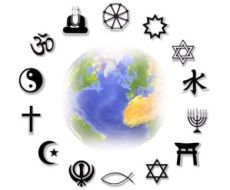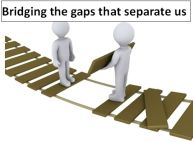Every now and then I get off on an ego trip and think that I should try to tackle some really weighty topic here, like religion. I started down that rat hole recently. One theme that I  had in mind was to write about the various books or spiritual writings that underpin the religions of the world. The Bible was the one that I am most familiar with and I knew the names of a few others from some of the religions that I at least know exist.
had in mind was to write about the various books or spiritual writings that underpin the religions of the world. The Bible was the one that I am most familiar with and I knew the names of a few others from some of the religions that I at least know exist.
So, off I went on the Internet, making various Google inquiries to try to see what might be out there to read for some research. What a dumb idea! Within 5 minutes it became  apparent that the topic and the approach that I was taking are both overwhelming. Just looking at the so-called “major” religions of the world yielded more than 55; most of them having various books or writings which provide the foundation for the beliefs and practices of the believers in those religions.
apparent that the topic and the approach that I was taking are both overwhelming. Just looking at the so-called “major” religions of the world yielded more than 55; most of them having various books or writings which provide the foundation for the beliefs and practices of the believers in those religions.
The list if spiritual writings would have numbered in the hundreds and the list spanned everything from complete books to some ancient stone tablets and even included some fairly modern essays. That brought to mind the thought that a new religion might be based upon beliefs found on the writings in modern communications media, such as blog posts. I suppose that would be possible; although, I think a religion based upon Tweets would be too light weight to survive the test of time.
This definition of religions from the BBC web site that I found to be most interesting, mainly because it is generic and inclusive enough that it can be applied to all 55 of the world’s major religions:
Religion can be explained as a set of beliefs concerning the cause, nature, and purpose of the universe, especially when considered as the creation of a superhuman agency or agencies, usually involving devotional and ritual observances, and often containing a moral code governing the conduct of human affairs.
It was interesting that in almost every case the original religions have undergone numerous splits into factions, each with a different take on the practice of the religion or different interpretation of the same supporting materials and beliefs. It does not take one long to see the hand of man in all of the world’s religions or to recognize the influence of the human ego in the editing and presentation of the various religious scripts and books that exist. Since most claim to be divinely guided, it must have kept God busy, or at least amused for some time, as each new translation or interpretation required His “divine guidance”.
Of similar interest is the art that accompanies the writings for many religions. Again the ego of man is center stage with depictions of the major figures within the religion looking amazingly like modern men of whatever region the artworks for that religion is based within. The exceptions seem to be the far eastern religions where many of the “Gods” of the religions are certainly depicted as looking anything but human. Maybe that’s where the “superhuman agency” aspect is applied.
A fairly consistent, but somewhat troubling, theme that runs through most of these religions is that the adherents truly believe that their God is the only true God and that they are the only ones who “get it.” They are “the chosen ones”, so to speak. That serves to provide the underlying justification for much of the “them vs. us” mentality that is presently associated in the modern world with religions, at least in some places. Very few of the religions of the world actually recognize the other religions and most look with pity or disdain on those who do not believe as they do. The docks of human history are apparently filled with those who missed the boat on the one and only true religion when it sailed.
ones who “get it.” They are “the chosen ones”, so to speak. That serves to provide the underlying justification for much of the “them vs. us” mentality that is presently associated in the modern world with religions, at least in some places. Very few of the religions of the world actually recognize the other religions and most look with pity or disdain on those who do not believe as they do. The docks of human history are apparently filled with those who missed the boat on the one and only true religion when it sailed.
Of course there is always the possibility that all of the world’s religions are “true” and that the names that various religions have associated with the “superhuman agency” that they believe in all point to the same enigmatic entity. Since man has appointed himself the author, editor, keeper and interpreter of his own religious texts and books, he has essentially documented his religions in ways that made sense to him in whatever place and time he began to believe. The creators and keepers of the written materials stifle all argument within the community of believers, as I said earlier, by claiming that the words that were written and the edits that were later made were all “divinely guided.” How convenient for them.
The further down this rat hole that I went the more it became clear that this is a topic that defies logic or clear explanation, and is a topic that is not to be tackled within the confines of a blog post. That was OK, because it brought me back to the beginning and the realization that religion is something that really cannot be explained, but must just be believed. We make personal choices in our lives about which religion to affiliate with and what and how much to believe, as well as which of the rituals to observe. That also serves to differentiate religions from faith, since faith has no requirements for dogma or ritual observances. Each can exist without the other
The practice of our faith, through religion fills a very real need in our lives and the ability  to set aside logic and just believe allows us to accept that which we cannot explain. As Ralph Waldo Emerson put it – “All I have seen teaches me to trust the Creator for all I have not seen.” The fact that moral codes have been created around those beliefs also provides a needed part of a civilized social structure. We need religion in our lives because without it there is a vexing void in our understanding of the world and what is happening around us. Religions help us define the boundaries in life, beyond which you do not need to understand, just believe.
to set aside logic and just believe allows us to accept that which we cannot explain. As Ralph Waldo Emerson put it – “All I have seen teaches me to trust the Creator for all I have not seen.” The fact that moral codes have been created around those beliefs also provides a needed part of a civilized social structure. We need religion in our lives because without it there is a vexing void in our understanding of the world and what is happening around us. Religions help us define the boundaries in life, beyond which you do not need to understand, just believe.
So, I’m not going to spend any more time trying to explain religion, I’m just going to go back to believing. However, maybe I’ll spend a little time praying for all of the unfortunate people who missed the boat on in my religion. Maybe they just don’t get it.
 How many times after an event or encounter have you had to say to yourself, “Oh crap, I shouldn’t have said that or I shouldn’t have done that?” You erred on the other side of kindness and you know it. So, now you have to figure out a way to apologize and make it right.
How many times after an event or encounter have you had to say to yourself, “Oh crap, I shouldn’t have said that or I shouldn’t have done that?” You erred on the other side of kindness and you know it. So, now you have to figure out a way to apologize and make it right. chance. Perhaps that’s where some yoga training could come in handy.
chance. Perhaps that’s where some yoga training could come in handy. So, err on the side of kindness and take action in defense of what is right and you will seldom have to apologize later. You might also find later that you are quite proud of yourself; as well you should be, you did what was right and that is never an error.
So, err on the side of kindness and take action in defense of what is right and you will seldom have to apologize later. You might also find later that you are quite proud of yourself; as well you should be, you did what was right and that is never an error.


 Posted by Norm Werner
Posted by Norm Werner  elevator pitch. That was a short message that could be delivered in the span of time that someone might spend with you on an elevator while going to work. Usually these were timed to be delivered in 15-20 seconds (maybe a little longer for a skyscraper elevator ride), and they were supposed to contain enough content to quickly get across compelling information about yourself or your product so as to elicit the response of the other party being interested enough to what to know more. It was an interesting challenge.
elevator pitch. That was a short message that could be delivered in the span of time that someone might spend with you on an elevator while going to work. Usually these were timed to be delivered in 15-20 seconds (maybe a little longer for a skyscraper elevator ride), and they were supposed to contain enough content to quickly get across compelling information about yourself or your product so as to elicit the response of the other party being interested enough to what to know more. It was an interesting challenge. great bloggers, but lousy Tweeters. It would have been frustrating for them to try to squeeze their great ideas and arguments into a Tweet; however, I also suspect that they would have found a way to use and adopt the technology, as did those in most of the recent areas of citizen unrest and uprisings. Perhaps Paul Revere’s ride to Lexington would have been unnecessary if he could have just been able to Tweet that the British were coming by land.
great bloggers, but lousy Tweeters. It would have been frustrating for them to try to squeeze their great ideas and arguments into a Tweet; however, I also suspect that they would have found a way to use and adopt the technology, as did those in most of the recent areas of citizen unrest and uprisings. Perhaps Paul Revere’s ride to Lexington would have been unnecessary if he could have just been able to Tweet that the British were coming by land. much of it has become meaningless and not worthy of attention. That too may be laid at the doorstep of modern social media, where the location of a person or what they had for breakfast passes for “content”.
much of it has become meaningless and not worthy of attention. That too may be laid at the doorstep of modern social media, where the location of a person or what they had for breakfast passes for “content”. that are not of our own making. How we react to them and our ability to go to our happy place in times of stress or pain determines how well we make it through those times.
that are not of our own making. How we react to them and our ability to go to our happy place in times of stress or pain determines how well we make it through those times. A key thing that both yoga and meditation focus upon is helping you find a way back to your happy place, so that you can let go of the stress and let your body’s natural ability to heal itself make you well again. Of course there are lots of other things involved, but being able to get to that happy place is central to both. It is also a key to a happy and healthy life, whether you practice those disciplines or not.
A key thing that both yoga and meditation focus upon is helping you find a way back to your happy place, so that you can let go of the stress and let your body’s natural ability to heal itself make you well again. Of course there are lots of other things involved, but being able to get to that happy place is central to both. It is also a key to a happy and healthy life, whether you practice those disciplines or not. even seek out a good hypnotherapist. Talk with the instructor/therapist and let them know that you are there to try to recapture the ability to put aside the day’s stresses and get to that place that gives you peace. They will understand. Then, focus upon the process that they take you through to relax and let go and begin your search for that happy place that is still there, somewhere in the deep recesses of your mind. You knew it as a child and you can find it again. When you do find it; you will know that “everything’s gonna be alright”.
even seek out a good hypnotherapist. Talk with the instructor/therapist and let them know that you are there to try to recapture the ability to put aside the day’s stresses and get to that place that gives you peace. They will understand. Then, focus upon the process that they take you through to relax and let go and begin your search for that happy place that is still there, somewhere in the deep recesses of your mind. You knew it as a child and you can find it again. When you do find it; you will know that “everything’s gonna be alright”. out why they always seem so calm and happy. They are at peace with God and themselves and that is a happy place to be, indeed.
out why they always seem so calm and happy. They are at peace with God and themselves and that is a happy place to be, indeed. place is out there waiting for you and you know that you can get back to it when you want to – and that’s a good thing …a happy thing.
place is out there waiting for you and you know that you can get back to it when you want to – and that’s a good thing …a happy thing. On this Martin Luther King day, America and the world are still struggling with many wrongs that need righting, many injustices that beg for justice and many old prejudices that seem to refuse to die. People still take to the streets, as they did in King’s day seeking redress of the wrongs, although many times not as peacefully as he would have liked. Too often there is still a lack of recognition between the right and wrong positions in many of the areas that still cause division and pain. There is too much of a mentality of “them vs. us”; rather than searching for a solution that involves “we”.
On this Martin Luther King day, America and the world are still struggling with many wrongs that need righting, many injustices that beg for justice and many old prejudices that seem to refuse to die. People still take to the streets, as they did in King’s day seeking redress of the wrongs, although many times not as peacefully as he would have liked. Too often there is still a lack of recognition between the right and wrong positions in many of the areas that still cause division and pain. There is too much of a mentality of “them vs. us”; rather than searching for a solution that involves “we”. their righteousness in their “defense of American Family values.” Apparently they think it is OK to discriminate so long as they also proclaim themselves to be evangelicals who are mounting a Bible-based defense of American life as they define it. What’s that old saying about two wrongs not making a right? That’s apparently not in their Bible.
their righteousness in their “defense of American Family values.” Apparently they think it is OK to discriminate so long as they also proclaim themselves to be evangelicals who are mounting a Bible-based defense of American life as they define it. What’s that old saying about two wrongs not making a right? That’s apparently not in their Bible. political power. He also found new adversaries to try to hold in check – those who were different from him in almost any way. For quite some time this new strategy worked well by employing tactics such as direct political contributions, Political Action Committees and gerrymandering to maintain political power. That political power allowed the structuring of laws that stripped away what power the masses has accumulated through the tort process or via organized labor. Rather rapidly, in terms of history, those in power amassed most of the wealth of the country, too. Now the top 1% of the world’s people control 99% of the wealth of the entire world, and with that wealth they can buy all of the power that they need to maintain their positions.
political power. He also found new adversaries to try to hold in check – those who were different from him in almost any way. For quite some time this new strategy worked well by employing tactics such as direct political contributions, Political Action Committees and gerrymandering to maintain political power. That political power allowed the structuring of laws that stripped away what power the masses has accumulated through the tort process or via organized labor. Rather rapidly, in terms of history, those in power amassed most of the wealth of the country, too. Now the top 1% of the world’s people control 99% of the wealth of the entire world, and with that wealth they can buy all of the power that they need to maintain their positions. is full of instances of the people eventually getting fed up with existing on the crumbs that fall off the tables of the rich rulers and rising up against them.
is full of instances of the people eventually getting fed up with existing on the crumbs that fall off the tables of the rich rulers and rising up against them. certainly exposed the carnage that rabid partisanship has wrecked upon both parties. The huge philosophical divide between the parties and the lack of interest in any compromise has left the entire middle of the political spectrum abandoned and ripe for a third party effort. Unfortunately, the only way that anyone can mount a campaign effort for President these days is to first acquire a billion dollars or more.
certainly exposed the carnage that rabid partisanship has wrecked upon both parties. The huge philosophical divide between the parties and the lack of interest in any compromise has left the entire middle of the political spectrum abandoned and ripe for a third party effort. Unfortunately, the only way that anyone can mount a campaign effort for President these days is to first acquire a billion dollars or more. sound bites and personal attacks along the candidates; however, I did recently watch the reruns of the last republican “debate”. It was obvious that the closer to the center of the stage a candidate was placed measured not only his current polling strength, but also his adherence to the tea party conservative line. The only candidates who made statements that seemed to both thoughtful and reasonable in a political environment that is begging for compromise were the politicians relegated to the far ends of the stage. Of course they spent most of the evening off camera.
sound bites and personal attacks along the candidates; however, I did recently watch the reruns of the last republican “debate”. It was obvious that the closer to the center of the stage a candidate was placed measured not only his current polling strength, but also his adherence to the tea party conservative line. The only candidates who made statements that seemed to both thoughtful and reasonable in a political environment that is begging for compromise were the politicians relegated to the far ends of the stage. Of course they spent most of the evening off camera. it. At least it is somewhat like a modern TV comedy, filled with ridiculous characters sparing with each other with words rather than swords. Like a TV show, or a movie, it requires that you suspend your disbelief for a period and just enjoy it, laugh along and don’t think about the horrible consequences of any of these clowns actually get elected. It’s only a hoot if you don’t stop to cry.
it. At least it is somewhat like a modern TV comedy, filled with ridiculous characters sparing with each other with words rather than swords. Like a TV show, or a movie, it requires that you suspend your disbelief for a period and just enjoy it, laugh along and don’t think about the horrible consequences of any of these clowns actually get elected. It’s only a hoot if you don’t stop to cry. I’ve written here a few time about wasting time and energy on worrying about stuff, rather than coming up to fix things that you can do something about. The secret to success in Ellington’s little quote is figuring out the difference between those things that you can do something about and those that you can’t. Unfortunately this is not an easy skill to develop r to consistently apply in our everyday lives. The result is that we spend too much time worrying about things that we can’t change, impact or fix.
I’ve written here a few time about wasting time and energy on worrying about stuff, rather than coming up to fix things that you can do something about. The secret to success in Ellington’s little quote is figuring out the difference between those things that you can do something about and those that you can’t. Unfortunately this is not an easy skill to develop r to consistently apply in our everyday lives. The result is that we spend too much time worrying about things that we can’t change, impact or fix. Let’s face it, there are many problems in the world around us that are worrisome, but which we can do little about. World hunger, wars, diseases, income and wealth inequities come to mind, as do a number of other very large and very widespread problems that we sometime worry about. Some find a solution to their worries by jumping into some cause or movement that is focused upon these bigger problems and that’s not a bad thing, if you can let go of your personal worry and focus on the group mission.
Let’s face it, there are many problems in the world around us that are worrisome, but which we can do little about. World hunger, wars, diseases, income and wealth inequities come to mind, as do a number of other very large and very widespread problems that we sometime worry about. Some find a solution to their worries by jumping into some cause or movement that is focused upon these bigger problems and that’s not a bad thing, if you can let go of your personal worry and focus on the group mission. instance, while too wide spread of an issue to be solved by one person, is such that the actions of each individual are helpful and additive towards resolving the problem. If one takes the attitude and approach that the end of bullying begins with me, then there may be one less action or statement or display that reinforces the practice. The foundation of change is to stop the old way and then go forward from that fresh beginning. Stopping bullying when you see it or standing up for those being bullied removes one more worry from your plate, because you could do something about that and you did.
instance, while too wide spread of an issue to be solved by one person, is such that the actions of each individual are helpful and additive towards resolving the problem. If one takes the attitude and approach that the end of bullying begins with me, then there may be one less action or statement or display that reinforces the practice. The foundation of change is to stop the old way and then go forward from that fresh beginning. Stopping bullying when you see it or standing up for those being bullied removes one more worry from your plate, because you could do something about that and you did. never even try the thing at which we are worried about failing. In our personal relations, our worries (fears) about possibly being rejected keep us in our seats instead of asking the girl or guy of our dreams for a dance or a date. Those, too, are worries that we can do something about.
never even try the thing at which we are worried about failing. In our personal relations, our worries (fears) about possibly being rejected keep us in our seats instead of asking the girl or guy of our dreams for a dance or a date. Those, too, are worries that we can do something about. ur time worrying about the consequences of an action that you are to frozen by fear to even take. Go for it! Do it! It won’t kill you and maybe you’ll even get the answer that you hoped for and not the one that you are spending all of your time worrying about. If you want to worry about something, worry about where you’ll go on the date or whether or not you can dance if you get the chance. It least those are things that you can do something about.
ur time worrying about the consequences of an action that you are to frozen by fear to even take. Go for it! Do it! It won’t kill you and maybe you’ll even get the answer that you hoped for and not the one that you are spending all of your time worrying about. If you want to worry about something, worry about where you’ll go on the date or whether or not you can dance if you get the chance. It least those are things that you can do something about. run away playing tag. It hurt; but, your mom kissed it and told you it was just a boo-boo and that you’d be OK – you’d live. Life’s failure are much the same, only mom isn’t there anymore. If you’re lucky you have a life partner who can kiss you and tell you that it’s just a boo-boo and that you’ll live. That failure is just a bruise (primarily to your ego) it’s not a tattoo. It may take a while for the bruise to heal and for you to forget about it, but it will heal eventually and you will forget and move on with life.
run away playing tag. It hurt; but, your mom kissed it and told you it was just a boo-boo and that you’d be OK – you’d live. Life’s failure are much the same, only mom isn’t there anymore. If you’re lucky you have a life partner who can kiss you and tell you that it’s just a boo-boo and that you’ll live. That failure is just a bruise (primarily to your ego) it’s not a tattoo. It may take a while for the bruise to heal and for you to forget about it, but it will heal eventually and you will forget and move on with life. rejection by someone that we hoped would be a loved one, loss of a job, divorce and more can all cause bruises. All of those bruises heal over time, though some require quite a bit longer than others.
rejection by someone that we hoped would be a loved one, loss of a job, divorce and more can all cause bruises. All of those bruises heal over time, though some require quite a bit longer than others. or maybe even a scar; you can look at that tattoo and say out loud, “this is the only thing that is permanent in my life.” That will start the healing process. If you really don’t want a tattoo, get one of those bracelets that have WWJD engraved or printed on them and wear that; because what Jesus would do is kiss your boo-boo and make it better.
or maybe even a scar; you can look at that tattoo and say out loud, “this is the only thing that is permanent in my life.” That will start the healing process. If you really don’t want a tattoo, get one of those bracelets that have WWJD engraved or printed on them and wear that; because what Jesus would do is kiss your boo-boo and make it better. had in mind was to write about the various books or spiritual writings that underpin the religions of the world. The Bible was the one that I am most familiar with and I knew the names of a few others from some of the religions that I at least know exist.
had in mind was to write about the various books or spiritual writings that underpin the religions of the world. The Bible was the one that I am most familiar with and I knew the names of a few others from some of the religions that I at least know exist. apparent that the topic and the approach that I was taking are both overwhelming. Just looking at the so-called “major” religions of the world yielded more than 55; most of them having various books or writings which provide the foundation for the beliefs and practices of the believers in those religions.
apparent that the topic and the approach that I was taking are both overwhelming. Just looking at the so-called “major” religions of the world yielded more than 55; most of them having various books or writings which provide the foundation for the beliefs and practices of the believers in those religions. ones who “get it.” They are “the chosen ones”, so to speak. That serves to provide the underlying justification for much of the “them vs. us” mentality that is presently associated in the modern world with religions, at least in some places. Very few of the religions of the world actually recognize the other religions and most look with pity or disdain on those who do not believe as they do. The docks of human history are apparently filled with those who missed the boat on the one and only true religion when it sailed.
ones who “get it.” They are “the chosen ones”, so to speak. That serves to provide the underlying justification for much of the “them vs. us” mentality that is presently associated in the modern world with religions, at least in some places. Very few of the religions of the world actually recognize the other religions and most look with pity or disdain on those who do not believe as they do. The docks of human history are apparently filled with those who missed the boat on the one and only true religion when it sailed. to set aside logic and just believe allows us to accept that which we cannot explain. As Ralph Waldo Emerson put it – “All I have seen teaches me to trust the Creator for all I have not seen.” The fact that moral codes have been created around those beliefs also provides a needed part of a civilized social structure. We need religion in our lives because without it there is a vexing void in our understanding of the world and what is happening around us. Religions help us define the boundaries in life, beyond which you do not need to understand, just believe.
to set aside logic and just believe allows us to accept that which we cannot explain. As Ralph Waldo Emerson put it – “All I have seen teaches me to trust the Creator for all I have not seen.” The fact that moral codes have been created around those beliefs also provides a needed part of a civilized social structure. We need religion in our lives because without it there is a vexing void in our understanding of the world and what is happening around us. Religions help us define the boundaries in life, beyond which you do not need to understand, just believe. Bowie was apparently classified originally as a folk and blues singer when he started in the mid-1960’s. He quickly morphed into what might be called an early version of fusion in the 1970’s during which he explored the combinations of a wide variety of emerging trends and sounds in his albums. That set the stage for the emergence of his Ziggy Stardust persona at the end of the 1970’s and into the 1980’s. Never one to stand pat with a character for too long, he then morphed through a number of new stage personas. There is a definitive web presentation of the 12 stages of Bowie’s stage life to be found at –
Bowie was apparently classified originally as a folk and blues singer when he started in the mid-1960’s. He quickly morphed into what might be called an early version of fusion in the 1970’s during which he explored the combinations of a wide variety of emerging trends and sounds in his albums. That set the stage for the emergence of his Ziggy Stardust persona at the end of the 1970’s and into the 1980’s. Never one to stand pat with a character for too long, he then morphed through a number of new stage personas. There is a definitive web presentation of the 12 stages of Bowie’s stage life to be found at –  various music styles, some of which were just emerging at the time. Bowie himself was transitioning and maturing in his musical style. Near the end of that era he created the Ziggy Stardust persona and his career took off at a whole new level. Here are some of his works from the 1970’s –
various music styles, some of which were just emerging at the time. Bowie himself was transitioning and maturing in his musical style. Near the end of that era he created the Ziggy Stardust persona and his career took off at a whole new level. Here are some of his works from the 1970’s –  Scott Parker did a good review
Scott Parker did a good review  constitutional amendment to the Michigan Constitution that would protect the GLBT community from discrimination. Patterson is a well-known Republican conservative, but has also recognized the ugliness and hate that comes with discrimination. He is basically saying – respect other people’s way of living.
constitutional amendment to the Michigan Constitution that would protect the GLBT community from discrimination. Patterson is a well-known Republican conservative, but has also recognized the ugliness and hate that comes with discrimination. He is basically saying – respect other people’s way of living. general. Our modern day pharisees are the moralizing, so-called Christian evangelicals who seem to spend more time criticizing the lives of others than putting their own lives in order. Like the high priests and pharisees of old, these modern day pharisees are sure that they occupy the moral high-ground and that their way is the only right way to live. And like those hypocrites of old, they try to take actions to correct or discriminate against those who choose to live differently. In modern times this holier-than-thou group uses political power to try to legitimize their discrimination through laws (or lack of laws) aimed at those who are “different.” They wrap themselves in a false morality that does not – respect other people’s way of living.
general. Our modern day pharisees are the moralizing, so-called Christian evangelicals who seem to spend more time criticizing the lives of others than putting their own lives in order. Like the high priests and pharisees of old, these modern day pharisees are sure that they occupy the moral high-ground and that their way is the only right way to live. And like those hypocrites of old, they try to take actions to correct or discriminate against those who choose to live differently. In modern times this holier-than-thou group uses political power to try to legitimize their discrimination through laws (or lack of laws) aimed at those who are “different.” They wrap themselves in a false morality that does not – respect other people’s way of living. people who were immigrants escaping religious persecution due to the fact they the religion that they practiced at the time was different from the prevailing religion in England and Europe. It is convenient also to forget about the threat that their immigration to America posed to the Native Americans who were already here. They essentially took the country from those who owned it at the time. Imagine if the Native Americans had enacted a law stopping the flow of these refugees from religious persecution from entering America because they posed a threat. Maybe that would have solved everything. The early settlers obviously did not – respect other people’s way of living.
people who were immigrants escaping religious persecution due to the fact they the religion that they practiced at the time was different from the prevailing religion in England and Europe. It is convenient also to forget about the threat that their immigration to America posed to the Native Americans who were already here. They essentially took the country from those who owned it at the time. Imagine if the Native Americans had enacted a law stopping the flow of these refugees from religious persecution from entering America because they posed a threat. Maybe that would have solved everything. The early settlers obviously did not – respect other people’s way of living. us in return, no matter what lifestyle they choose to live. In the end, wouldn’t that make the whole world a better place in which to live? It would, because it would be a place in which we all would – respect other people’s way of living
us in return, no matter what lifestyle they choose to live. In the end, wouldn’t that make the whole world a better place in which to live? It would, because it would be a place in which we all would – respect other people’s way of living responsibility, much less worrying about how others live. We need to focus less on others and more on doing the right things ourselves to make sure that we aren’t becoming modern day pharisees and discriminating against those with lives that are different from ours. So, as we begin a new week maybe, before we leave the house today we can resolve to – respect other people’s way of living.
responsibility, much less worrying about how others live. We need to focus less on others and more on doing the right things ourselves to make sure that we aren’t becoming modern day pharisees and discriminating against those with lives that are different from ours. So, as we begin a new week maybe, before we leave the house today we can resolve to – respect other people’s way of living.